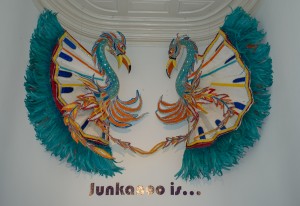
Junkanoo can’t really be explained.
Junkanoo can only be experienced, whether in the ten-hour parades marking Boxing Day and New Years in the Bahamas or in the casual rushes celebrating an event such as last night’s opening at the National Art Gallery of the Bahamas (NAGB) in Nassau.
At the turn of the year, it is an experience that combines dancing, drums, music, human-powered floats, all elaborately costumed for one parade. The drums drive through your chest; the whistles and cowbells pulse in your ears; and the trumpets, coronets and tubas add a melody line.
Whether on Bay Street or Shirley Street or amongst the crowds lining them, Junkanoo both requires and creates community. The vast bands, the hordes of dancers, the floats and costumes demand organisation and a focused, collective creativity.
I think as I watch that half this nation of 550,000 spread across 700 islands must be in the parade; everyone else must have worked on the costumes and come out to watch them go by.
An essential element of Junkanoo is the rivalry amongst the Saxons, the Valley Boys, One Family, the Prodigal Sons and other groups for the parade championship. Judges evaluate performers as they pass Parliament. Their tally sheets for each unit used to go into gray boxes pulled down the street accompanied by at least two police.
The arcane judging often produces litigation extending Junkanoo’s joys for some weeks after the New Year.
This year, both parade championships went to the Valley Boys, a result that seemed fitting as their co-founder and leader for 45 years, Winston ‘Gus’ Cooper, lay dying. A revered figure, Cooper is generally credited with bringing about Junkanoo as it’s now experienced.
The National Art Gallery of the Bahamas has always recognised the art of Junkanoo. It took the occasion of Cooper’s death to remember him with a show celebrating this rarely preserved art and the communities that create it.
‘The Ace of Spades’ – Mr. Cooper’s hard-earned title as the top card – is an exceptionally well-organised and informative show. A long, crowded wall traces the modern history of Junkanoo following the unrest of the Depression and WWII when it was prohibited. The irony of Mr. Cooper’s given names – Winston Roosevelt – goes unnoted.
The next room recreates a portion of the Valley Boys’s ‘shack’ where they design and create – in greatest secrecy – their costumes for the year’s end. Cardboard filled with sketches covers the walls. The thought of drawings of such quality ending in the rubbish would make a gallery owner weep.
A small alcove presents one of Boxing Day 2013’s most spectacular costumes. To its left and right are snaps of the progress of its construction which proves it to be far more complex even than the exquisite detail suggests.
The balance of the well-mounted exhibit displays additional costumes and details from floats. Set apart and spaced generously, one can appreciate the genius of the individual efforts, something hard to do in the noise and movement of a moment on Boxing Day. A mural captures themes from Valley Boy designs which have the complexity of Mayan ‘glyphs.
As I looked at the mural, I thought of the inadequacy of museums and historical sites. They preserve these wonderful artifacts but in isolation from the colors, pageantry and sounds that gave them collective significance.
Yes, each art work rewards the time spent with it – especially the way the NAGB presents them. But how inadequate they are emptied of the people who wore them, separated from the other costumes that surrounded them, mute and immobile.
Outside, we joined the rush. Perhaps 50 Valley Boys marched to the Gallery. No costumes. Just the joy of whistles and bells, drums and horns. And people.
***
For some pictures I’ve taken of Junkanoo: one, two, three, four, five, six.
Recent Comments